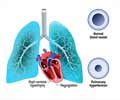High indoor temperatures and pollution worsen chronic obstructive pulmonary disease symptoms, and keeping indoor climate to optimum may improve health outcome.
Highlights:
- Chronic obstructive pulmonary disease (COPD) affects nearly 15 million people in the United States, and is the third main cause of mortality.
- Outdoor air pollution levels have been linked to increased respiratory symptoms in COPD and mortality.
- Recent studies have indicated that high indoor temperatures and pollution levels can also cause COPD exacerbation.
- Keeping indoor heat and pollution to optimal levels has the potential to improve disease outcome.
Reason For The Study
Though outdoor pollution is known to exacerbate COPD symptoms, there is very little research and evidence available on the effect of the quality of indoor air in COPD patients, especially in developed countries.Details of The Study
Meredith C. McCormack, MD, MHS, and her colleagues at the Johns Hopkins University conducted a longitudinal study on 69 volunteers suffering from moderate to severe COPD, during some of the hottest days of the year.
“Previous studies have found that the elderly are particularly vulnerable to the effect of heat and more likely to die or be hospitalized during heat waves,” said Dr. McCormack, an associate professor of medicine at Johns Hopkins and lead study author. “ To our knowledge, this is the first study to report an interactive effect between indoor temperature and indoor air pollution in COPD.”
The volunteers were asked to complete a daily questionnaire that included the Breathlessness, Cough, and Sputum Scale (BCSS), which contained a standardized rating of respiratory symptoms. In addition, their lung function was assessed by performing a daily spirometry. The frequency of using rescue inhalers to control their symptoms was recorded by the patients.
Results of The Study
- Participants of the study spent most of their time indoors. On the days they ventured out, it was for around two hours on an average.
- BCSS scores worsened with higher indoor temperatures and so did the use of rescue inhalers by the participants.
- The effect of increasing indoor temperatures was additionally magnified by high levels of indoor pollutants, namely PM2.5 and NO2. A 10 degree rise in temperature within the home at the 75th percentile of PM2.5 levels led to a severe increase in symptoms, as compared to only a mild aggravation of symptoms that occurred when the levels of PM2.5 were at the 25th percentile inside the home.
- Worsening of symptoms occurred immediately on exposure to higher indoor temperatures, and lasted for a couple of days.
- Lung function, which was assessed by spirometry, remained unaffected by rising indoor temperatures or increasing levels of indoor air pollutants.
- Inspite of 86 percent of the participants living in residences with some form of air conditioning, it was not turned on for 37 percent of the study days.
- There was an aggravation of respiratory symptoms on the days the participants spent outside, notwithstanding the fact that it was for a brief period only.
- Most elderly persons and those suffering from COPD spend the major part of their day indoors. Considering the fact, the findings of the study assume all the more importance. “Given that participants spent an overwhelming majority of their time indoors, which we believe is representative of patients with COPD generally, optimizing indoor climate and reducing indoor pollution represents a potential avenue for improving health outcomes,” Dr. McCormack said.
- The findings of the study present an opportunity for doctors and healthcare professionals to try targeted interventions. Also, policy and law makers need to take note of the findings and draw up strategies to minimize and protect the vulnerable population from the adverse effects of the climatic conditions.
Reference
- The Effects of Air Pollution and Temperature on COPD - (https://www.ncbi.nlm.nih.gov/pmc/articles/PMC4878829/)














